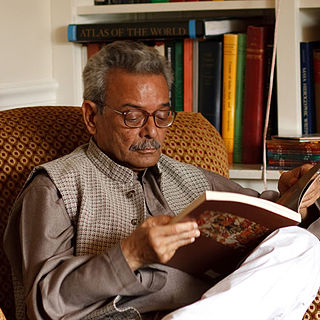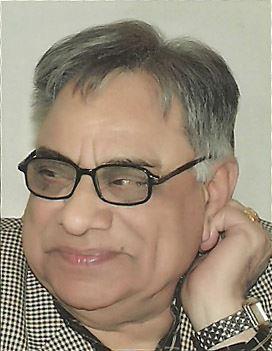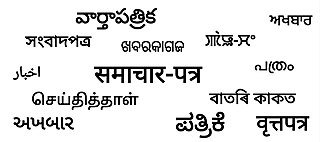Related Research Articles
Literature of Kashmir has a long history, the oldest texts having been composed in the Sanskrit language. Early names include Patanjali, the author of the Mahābhāṣya commentary on Pāṇini's grammar, suggested by some to have been the same to write the Hindu treatise known as the Yogasutra, and Dridhbala, who revised the Charaka Samhita of Ayurveda.
Mass media in India consists of several different means of communication: television, radio, cinema, newspapers, magazines, and Internet-based websites/portals. Indian media was active since the late 18th century. The print media started in India as early as 1780. Radio broadcasting began in 1927. Today much of the media is controlled by large, corporations, which reap revenue from advertising, subscriptions, and sale of copyrighted material.

Shamsur Rahman Faruqi was an Indian Urdu language poet, author, critic, and theorist. He is known for ushering modernism to Urdu literature. He formulated fresh models of literary appreciation that combined Western principles of literary criticism and subsequently applied them to Urdu literature after adapting them to address literary aesthetics native to Arabic, Persian, and Urdu. Some of his notable works included Sher-e-Shor Angez (1996), Ka’i Chand The Sar-e Asman (2006), The Mirror of Beauty (2013), and The Sun that Rose from the Earth (2014). He was also the editor and publisher of the Urdu literary magazine Shabkhoon.

Gopi Chand Narang was an Indian theorist, literary critic, and scholar who wrote in Urdu and English. His Urdu literary criticism incorporated a range of modern theoretical frameworks including stylistics, structuralism, post-structuralism, and Eastern poetics.
Khalish Dehlavi, who was born Kanwar Krishan Singh Bhayana, is a successful engineer and well-known Urdu poet of India. The Hindu highlighted the fact that, unusually, he has excelled in two very different fields: "Khalish is also a civil engineer who has designed the Sahar International Airport in Mumbai, the Jawaharlal Nehru Stadium here, and the election commissioner's office on the city's Ashoka Road. Poetry is Khalish's passion. Though he thanks his construction business for providing him with the luxuries of life, it is at a poetic soiree that Khalish comes into his own."

Ibn Sina Academy of Medieval Medicine and Sciences (IAMMS) is a trust registered under the Indian Trusts Act, 1882. Mohammad Hamid Ansari, former vice-chancellor of Aligarh Muslim University, Aligarh, formally inaugurated it on 21 April 2001. Department of AYUSH, Ministry of Health and Family Welfare, Government of India gave accreditation to the academy in 2004 and promoted it as 'centre of excellence' in 2008. Membership of the academy is open to anyone who has an interest in the academy's activities particularly on history of medicine and history of science. Being a charitable organization, donations to the Academy are also exempted from Income Tax under section 80G of the Income Tax Act 1961.
Saghar Nizami (1905–1983), also known as Samad Yar Khan, was an Indian poet and writer of ghazal and nazm in Urdu. He was one of the earliest disciples of Seemab Akbarabadi (1882–1951) and was a recipient of the third highest Indian honour of the Padma Bhushan, in 1969, for his contributions to literature.
Khushtar Girami (1902–1988) born Ram Rakha Mal Chadda, was a renowned Urdu writer and poet. He is more remembered as the editor of the then India’s leading Urdu Monthly Biswin Sadi which he also owned. He started publication of this magazine from Lahore in 1937, and later shifted to Delhi. He is credited with having introduced numerous budding Urdu and Hindi poets, short-story writers, novelists, essayists and literary critics. All renowned Urdu poets and writers were proud regular contributors to Biswin Sadi. His service to Urdu language is unforgettable. In 1977 he sold this magazine to Rehman Nayyar, the erstwhile owner and editor of Ruby, to lead a retired life. His book titled Sihat aur Zindagi published by Book Home in 1980, is a popular book on this subject.

Pratiyogita Darpan is an Indian bi-lingual magazine on current affairs and general knowledge specially useful for civil service exams and similar competitive exams.

Kewal Dheer is an Indian writer and author.

Udant Martand is the first Hindi language newspaper published in India. Started on 30 May 1826, from Calcutta, the weekly newspaper was published every Tuesday by Pt. Jugal Kishore Shukla. It was closed on 4 December 1827 due to financial crisis.

The Media in Gujarati language started with publication of Bombay Samachar in 1822. Initially the newspapers published business news and they were owned by Parsi people based in Bombay. Later Gujarati newspapers started published from other parts of Gujarat. Several periodicals devoted to social reforms were published in the second half of the 19th century. After arrival of Mahatma Gandhi, the Indian independence movement peaked and it resulted in proliferation of Gujarati media. Following independence, the media was chiefly focused on political news. After bifurcation of Bombay state, the area of service changed. Later there was an increase in readership due to growth of literacy and the media houses expanded its readership by publishing more editions. Later these media houses ventured into digital media also. The radio and television media expanded after 1990.
Wajida Tabassum was an Indian writer of fiction, verses and songs in the Urdu language. She wrote 27 books. Some of her stories have been made into movies and Indian television serials. Her controversial 1975 story titled "Utran" was made into a popular soap opera on Indian television in 1988. "Utran" was reprinted in English translation as part of an anthology of 20 short stories titled Such Devoted Sisters in 1994, and from there was made into a movie in 1996 under the title Kama Sutra: A Tale of Love, with a script by Mira Nair and Helena Kriel.
Syed Naseer Hussain is an Indian politician of Indian National Congress and a Member of the upper house of the Indian Parliament, the Rajya Sabha, from the state of Karnataka. He served as National Media Panelist (AICC) for the past three years. He also served as National Secretary and Chief Election Authority of Indian Youth Congress. He also served as the Chairman of various committees; Vice-Chairman, two labour boards and Chairman, two sub- committees, Government of India. He is from Bellary. He appointed as member of CWC in Congress. Currently, Hussain serves on the Congress Working Committee as a full time Member and is responsible for managing the office of the Indian National Congress President Mallikarjun Kharge.

Giriraj Kishore was an Indian writer, who was awarded the Padma Shri by the president of India in 2007. He lived in Kanpur and served as the registrar of IIT Kanpur. He was given the Sahitya Akademi Award in 1992, the Vyas Samman in 2000, and an honorary Ph.D. by Chhatrapati Shahu Ji Maharaj University in 2002.

Shama was a monthly Indian Urdu-language film and literary magazine published from 1939 to 1999. Considered the world's biggest chain of Urdu-language magazines at the time, the Shama group published several other famous magazines and digests including Sushama (Hindi), Khilauna, Dost aur Dosti, Bano, Sushmita, Mujrim, Doshi, A'inah, Shabistan and Rasia Kashidakari. The magazine was a household name and has been described as a "movement of Urdu which gave birth to a new tradition".

Shāh Muḥammad Ibrāhīm ʿAlī was a Bengali Islamic scholar, poet and activist of the Khilafat Movement. He wrote poetry in the Bengali, Urdu and Persian languages under the pen name of Tashna. His magnum opus Agnikuṇḍa is a compilation of his writings during his imprisonment.

Thangching or Thangjing is a primordial deity in Sanamahism, the indigenous religion of Manipur. He is the ruling deity of the Moirang dynasty. He rules supreme on the banks of the landlocked sea, Loktak lake. He is one of the four cardinal Umang Lais. The guardianship of the south western direction is alluded to Thangjing and the other directions to Koubru, Marjing and Wangbren.

Da'watul Haq was a quarterly Arabic magazine published by Darul Uloom Deoband under the supervision of Muhammad Tayyib Qasmi from 1965 to 1975, subsequently replaced by Al-Da'i. Founded and developed by Wahiduzzaman Kairanawi, it became Darul Uloom Deoband's inaugural Arabic magazine, with the primary mission of acquainting Arabic-speaking regions with Darul Uloom Deoband and translating its educational content into Arabic. The magazine aimed to present Islam as a dynamic and relevant faith, addressing objections and emphasizing that the Quran and Islam serve as foundations for progress rather than impediments. It also aimed to elevate the Arabic language and literature in both India and the Arab world. Scholars like Saeed Ahmad Akbarabadi and Muhammad Salim Qasmi commenced on their literary journeys with this publication.
References
- ↑ NATARAJAN, J. (1955). History of Indian Journalism. Publications Division Ministry of Information & Broadcasting. ISBN 9788123026381.
- ↑ Board, Pratiyogita Darpan Editorial. Pratiyogita Darpan. Upkar Prakashan.
- ↑ Urfi, Jamil. "'Biswin Sadi': How I came of age in the 1960s with long-gone Urdu magazines and books of the time". Scroll.in. Retrieved 2021-02-23.
- ↑ "Remembering Z Rahman Naiyar and Biswin Sadi". The World of Urdu Poetry, Literature & News. 2010-01-17. Retrieved 2018-10-19.
- ↑ Eur (2002). The Far East and Australasia 2003. Psychology Press. ISBN 9781857431339.
- ↑ "Closure of Biswin Sadi: End of an Era in Urdu journalism". Indscribe. 2008-03-26. Archived from the original on 2021-01-26. Retrieved 2021-02-23.
- ↑ "Awards". www.milligazette.com. Retrieved 2018-10-27.
- ↑ Editor (2014-02-14). "Urdu Sphere: Language, Literature, Learning ھندوستان سے ایک اردو بلاگ: Urdu magazine Biswin Sadi's latest issue hits the stands". Urdu Sphere. Retrieved 2018-10-27.
{{cite web}}:|last=has generic name (help)